#abrar alvi
Photo
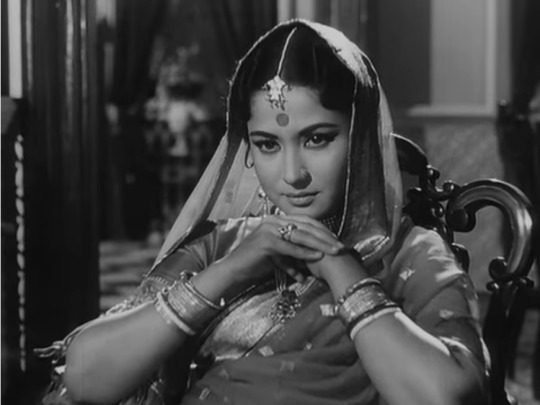


Meena Kumari in Sahib Bibi Aur Ghulam (1962) // dir. Abrar Alvi
#Sahib Bibi Aur Ghulam 1962#Sahib Bibi Aur Ghulam#meena kumari#abrar alvi#indian cinema#hindi cinema#cinema#films#movies#film scenes#movie scenes#screencaps#cinematography#bollywood#old bollywood#bollywood movies#classic bollywood#classic cinema#world cinema#1962#1960s#period movies#period drama#period films#indian films#indian movies#indian actress#1960s cinema
132 notes
·
View notes
Text
youtube
Legal, free, with English subs and amazing quality upload on YouTube's best channel for classic Indian Cinema.
#Sahib Bibi aur Ghulam#Old Bollywood#bw#video#1962#1960s#Indian Cinema#bollywood2#bollywood#vintage bollywood#Guru Dutt#Meena Kumari#Waheeda Rehman#Rehman#Minoo Mumtaz#Sapru#Abrar Alvi#VK Murthy#Hemant Kumar#Youtube#tommydan55
29 notes
·
View notes
Photo

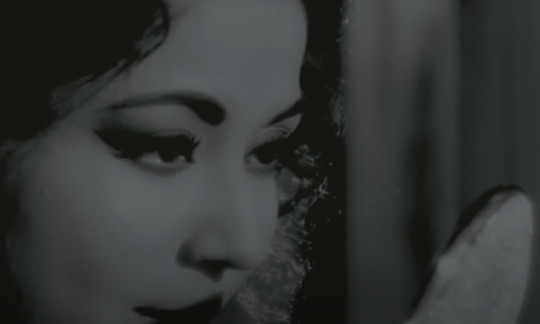

Sahib Bibi Aur Ghulam (1962)
28 notes
·
View notes
Text
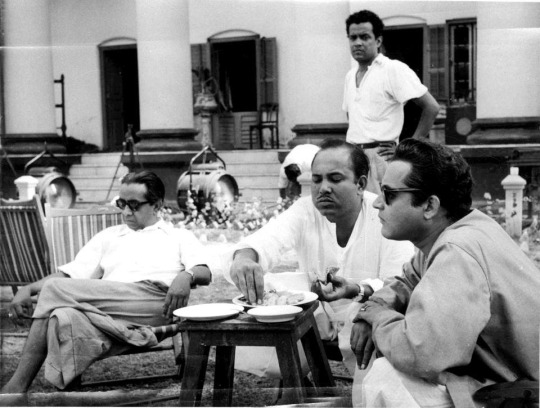
Remembering #AbrarAlvi, the illustrious screenwriter and dialogue writer in Hindi films, on his 14th death anniversary (18/11/09).
He was a key member of Guru Dutt's team and known for writing films like "Aar-Paar," "Sahib Bibi Aur Ghulam," "Kaagaz Ke Phool," "Pyaasa," and "Mr. & Mrs. '55." In 1953, while on the set of "Baaz," he met Guru Dutt. Dutt was struggling with a scene, and he offered a suggestion that impressed Dutt so much that he asked him to write "Aar-Paar." This led to him becoming a vital part of Dutt's team.
The films he worked on with Dutt are now considered classics worldwide. He also directed the successful movie "Sahib Bibi Aur Ghulam." He appeared in a touching three-part documentary about Guru Dutt, reflecting on their work together. This documentary was made by Channel 4 and is included in the DVD extras for "Kaagaz Ke Phool" and "Chaudhvin ka Chand."
After working with Guru Dutt and a controversy over who really directed "Sahib Bibi Aur Ghulam," he found it hard to make a mark as a director. But he continued to write screenplays and dialogues for many films, some of which were big hits, like "Professor," "Prince," and "Suraj." He also worked with Rajesh Khanna, writing for "Janta Hawaldar" and doing the screenplay and dialogues for "Begunaah."
In this photo, Director Abrar Alvi enjoys snacks in the company of #GuruDutt on the sets of the movie Sahib Bibi Aur Ghulam (1962).
3 notes
·
View notes
Text




First Indian CinemaScope film and last film directed by the legendary Guru Dutt.
The innocence portrayed by the protégé Waheeda Rehman and the strength shown in choosing an incomplete life, is talked about less, when the other character is played by her mentor himself.

GuruDutt’s melancholic hold over the entire film was made possible through VK Murthy’s precise and thought-out lighting. It is then you realise the cinematographer’s contribution in delivering to the world a dream, out of the director’s womb.
And how it would break a person if that dream was not just a film but your whole idea of reality, and it fails to find its place in the reality of Life.
Kaagaz Ke Phool (1959) was not a commercial success like Pyaasa, CID, Mr and Mrs 55; it was disliked right from the premiere for introducing the audiences to the dark side of showbiz. Fast forward to 1980s, it received the recognition it desired and lamented for, being given titles like “a masterpiece” or “a cult classic.” It is hard to believe it is the same film that broke the already broken man. He left, his search for meaning through his work had failed him, or so he thought. We couldn’t comprehend and he couldn’t wait.
However, there are endless articles now, discussing every little detail of the film. International film festivals laud Guru Dutt for his creative thirst. We are celebrating its release even today in 2024. Is it because we have come close to accepting the paper flowers more practically now, given the simulated feelings have become our only basis to study depth.

It is not so simple to describe Kaagaz Ke Phool as a tragedy of two lonely people seeking support in each other, when the great actor-director goes beyond the film and lives the character. It is brilliant as much as it is tragic.
#kaagaz ke phool#guru dutt#waheeda rehman#cult classic#magnum opus#s d burman#screenplay#cinematography#v k murthy#geeta dutt#hindi cinema#bollywod#showbiz#noir#philosophical#black and white#abrar alvi#tragedy#melancholy
1 note
·
View note
Photo
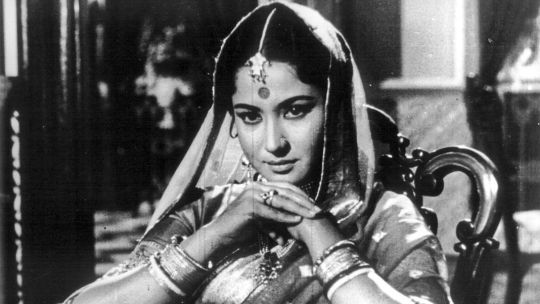
Seen in 2023:
Sahib Bibi Aur Ghulam (Abrar Alvi), 1962
#films#movies#stills#Sahib Bibi Aur Ghulam#Master Mistress and Servant#Abrar Alvi#Meena Kumari#Indian#musicals#1960s#seen in 2023
1 note
·
View note
Video
youtube
Jaba sings Bhanwara bada nadan hain in a scene from Sahib Bibi Aur Ghulam - Actress: Waheeda Rehman; Vocals: Asha Bhosle
#cinema#indian cinema#sahib bibi aur ghulam#abrar alvi#bimal mitra#asha bhosle#hemanta mukherjee#shakeel badayuni#waheeda rehman#bw#guru dutt#hemant kumar#v.k. murthy#y.g. chawhan
20 notes
·
View notes
Photo

Kaagaz Ke Phool (1959, India)
Almost a quarter of the way through the twenty-first century, globalization has pierced the remotest corners of the planet. The examples academics and politicians cite demonstrating this globalization are almost always economic, but the most profound examples are cultural. Once known only in South Asia, Indian cinema has burst onto a global stage. Its stars and its most popular directors seem larger than life. Reading on some of modern Bollywood’s (Hindi-language cinema) personalities, I find few of their biographies compelling beyond their unquestionable status as South Asian and international celebrities – I won’t name names here because that is for another time. That is partly a result of not watching enough Bollywood films. It is also because I am making unconscious comparisons between those modern actors to actor-director Guru Dutt. Dutt was a tragic romantic – off- and on-screen – to the point where those personas can become indistinguishable.
As an actor, Dutt can be as charming a romantic male lead as anyone, as well as lend a film the dramatic gravitas it needs. As a director, he refined his sweeping visuals and theatrical flairs over time. That artistic development culminated with Pyaasa (1957) and his final directorial effort, Kaagaz Ke Phool (“Paper Flowers” in English). The latter film is the subject of this piece. Both films elevate themselves to a cinematic altitude few movies anywhere, anytime ever accomplish. They are, for lack of a better word, operatic* – in aesthetic, emotion, storytelling, tone. In Kaagaz Ke Phool, Dutt once again lays bare his artistic soul in what will be his final directed work.
An old man enters a film studio’s empty soundstage, climbs onto the rafters, and gazes wistfully at the darkened workspace below. We learn that this is Suresh Sinha (Dutt), a film director whose illustrious past exists only in old film stock. The film is told in flashback, transporting to a time when his marriage to Bina (Veena) is endangered – the parents-in-law disdain his film work as disreputable to their social class – and he is embarking upon an ambitious production of Devdas (a Bengali romance novel that is among the most adapted pieces of Indian literature to film, the stage, and television). He is having difficulty finding someone to play Paro, the female lead. Due to this conflict, Bima has also forbidden their teenage daughter, Pammi (Kumari Naaz), from seeing Suresh. Pammi is sent to a boarding school far from Delhi (where Bima and her parents reside) and further from Mumbai (where Suresh works), without any sufficient explanations of the spousal strife.
One rainy evening, Suresh generously provides his coat to a woman, Shanti (an excellent Waheeda Rehman). The next day, Shanti arrives at the film studio looking to return the coat. Not knowing anything about film production, she accidentally steps in front of the camera while it is rolling – angering the crew who are tiring of yet another production mishap. Later, while viewing the day’s rushes, Suresh casts Shanti as Paro after witnessing her accidental, but remarkable, screen presence. She achieves cinematic stardom; Suresh and Shanti become intimate. When the tabloid gossip eventually reaches Mumbai and Pammi’s boarding school, it leads to the ruin of all.
What did you expect from an operatic film – a happy ending?
Also starring in the film are Johnny Walker (as Suresh’s brother-in-law, “Rocky”) and Minoo Mumtaz (as a veterinarian). Walker and Mumtaz’s roles are vestigial to Kaagaz Ke Phool. Their romantic subplot is rife with the potential for suggestive humor (she is a horse doctor), but the screenplay never justifies their inclusion in the film.
Shot on CinemaScope lens licensed by 20th Century Fox to Dutt’s production company, Kaagaz Ke Phool is Dutt’s only film shot in letterboxed widescreen. From the onset of his directorial career and his close collaboration with cinematographer V.K. Murthy, Dutt exemplifies an awesome command of tonal transition and control. Murthy’s dollying cameras intensify emotion upon approach: anguish, contempt, sober realization. These techniques render these emotions painfully personal, eliminating the necessity of a few lines of dialogue or supplemental motion from the actor. The effect can be uncomfortable to those who have not fully suspended their disbelief in the plot or the songs that are sung at the time. But to the viewers that have accepted that Dutt’s films exist in a reality where songs about infatuation, love, loss, and regret are sung spontaneously (and where revelations are heard in stillness), this is part of the appeal. Dutt and Murthy’s lighting also assists in directing the narrative and setting mood: a lashing rainstorm signaling a chance meeting that seals the protagonists’ fates, the uncharacteristically film noir atmosphere of the soundstage paints moviemaking as unglamorous, and a beam of light during a love melody evokes unspoken attraction. That final example represents the pinnacle of Dutt and Murthy’s teamwork (more on this later).
As brilliant as his films (including this) may be, Dutt suffered during mightily during Kaagaz Ke Phool’s production. In writings about Dutt, one invariably encounters individuals who believe Dutt’s life confirms that suffering leads to great art. Though I think it best to retire that aphorism so as not to romanticize pain, I believe that the reverse is true with Guru Dutt – his later directing career contributed to his personal tribulations. In some ways, that suffering informed his approach to what I consider an informal semiautobiographical trilogy of his films: Mr. & Mrs. ’55 (1955), Pyaasa, and Kaagaz Ke Phool. Dutt directed and starred in each of these films. In each film he plays an artist (a cartoonist, poet, and film director, respectively); with each successive film his character begins with a greater reputation, only to fall further than the last. The three Dutt protagonists encounter hardship that do not discriminate by caste, professional success, or wealth.
For Dutt’s Suresh, he is unable to consummate his love for Shanti because the specters of his failed marriage haunt him still. He never speaks to his de facto ex, but marital disappointment lingers. Why does he bother visiting his stuffy in-laws when he knows they will never change their opinions about him? Abrar Alvi’s (the other films in the aforementioned informal Dutt-directed trilogy, 1962’s Sahib Bibi Aur Ghulam) screenplay is silent on the matter. Also factoring into Suresh’s hesitation is his daughter, Pammi. Pammi is young, looks up to both her parents, and cannot fathom a parent being torn from her life. Her reaction to learning about Shanti implies that neither of her parents have ever truly talked to her about their separation. Pammi does not appear to blame herself, but it seems that her parents – intent on protecting their child, perhaps speaking to her not as a soon-to-be young adult – are loath to maturely talk about the other. In a sense, Pammi has never mourned her parents’ marriage as we see her deny the tabloid reports about Suresh’s affair and express anger towards her father when she learns the truth.
When Suresh’s film after Devdas flops, his film career is in tatters. But Shanti’s popularity is ascendant, creating a dynamic reminiscent of A Star is Born. In a faint reference to Devdas, Kaagaz Ke Phool’s final act contains anxieties about falling into lower classes. If Kaagaz Ke Phool is contemporaneous to its release date, one could also interpret this as concerns about falling within India’s caste system (reformist India in the late 1950s was dipping its toes into criminalizing caste discrimination, which remains prevalent). Suresh’s fall is stratospheric and, in his caste-conscious, masculine pride, he rejects Shanti’s overtures to help him rebuild his life and film career. This tragedy deepens because Shanti’s offer is in response to the contractual exploitation she is enduring. We do not see what becomes of Shanti after her last encounter with Suresh, but his final scenes remind me, again, of opera: the male lead summoning the strength to sing (non-diegetically in Suresh’s case) his parting, epitaphic thoughts moments before the curtain lowers.
Suresh’s and Shanti’s respective suffering was preventable. Whether love may have assuaged his self-pity and alcoholism and her professional disputes is debatable, but one suspects it only could have helped.
Composer S.D. Burman (Pyaasa, 1965’s Guide) and lyricist Kaifi Azmi (1970’s Herr Raanjha, 1974’s Garm Hava) compose seven songs for Kaagaz Ke Phool – all of which elevate the dramatics, but none are as poetic as numbers in previous Dutt films. Comments on two of the most effective songs follow; I did not find myself nearly as moved by the others.
��Dekhi Zamane Ki Yaari” (roughly, “I Have Seen How Deeply Friendship Lies”) appears just after the opening credits, as an older Suresh ascends the soundstage’s stairs to look down on his former domain. The song starts with and is later backed by organ (this is an educated guess, as many classic Indian films could benefit with extensive audio restorations as trying to figure out their orchestrations can be difficult) and is sung non-diegetically by Mohammed Rafi (dubbing for Dutt). A beautiful dissolve during this number smooths the transition into the flashback that will frame the entire film. That technique, combined with “Dekhi Zamane Ki Yaari”, prepares the audience for what could be a somber recollection. However, this is only the first half of a bifurcated song. The melodic and thematic ideas of “Dekhi Zamane Ki Yaari” are completed in the film’s final minutes, “Bichhde Sabhi Baari Baari” (“They All Fall Apart, One by One”; considered by some as a separate song). Together, the musical and narrative arc of this song/these songs form the film’s soul. For such an important musical number, it may have been ideal to incorporate it more into the film’s score, but now I am being picky.
Just over the one-hour mark, “Waqt Ne Kiya Haseen Sitam” (“Time Has Inflicted Such Sweet Cruelty On Us”; non-diegetically sung by Shanti, dubbed by Geeta Dutt, Guru’s wife) heralds the film’s second act – Suresh and Shanti’s simultaneous realization of their unspoken love, and how they are changed irrevocably for having met each other. Murthy’s floating cameras and that piercing beam of light are revelatory. A double exposure during this sequence shows the two characters walking toward each other as their inhibitions stay in place, a breathtaking mise en scène (the arrangement of a set and placement of actors to empower a narrative/visual idea) foreshadowing the rest of the film.
Dutt’s perfectionist approach to Kaagaz Ke Phool fueled a public perception that the film was an indulgent vanity exercise with a tragic ending no one could stomach viewing. Paralleling Suresh and Shanti’s romantic interest in each other in this film, the Indian tabloids were printing stories claiming that Dutt was intimate with co-star Waheeda Rehman and cheating on Geeta Dutt. These factors – perhaps some more than others (I’m not versed on what Bollywood celebrity culture was like in the 1950s, and Pyaasa’s tragic ending didn’t stop audiences from flocking to that film) – led to Kaagaz Ke Phool’s bombing at the box office. Blowing an unfixable financial hole into his production company, Guru Dutt, a man who, “couldn’t digest failure,” never directed another film. Like the character he portrays here, Dutt became an alcoholic and succumbed to depression in the wake of this film’s release. Having dedicated himself entirely to his films, he interpreted any professional failure as a personal failure.
Kaagaz Ke Phool haunts from its opening seconds. Beyond his home country, Dutt would not live to see his final directorial effort become a landmark Bollywood film and his international reputation growing still as cinematic globalization marches forth. Dutt’s most visually refined films, including Kaagaz Ke Phool, are films of subtraction. The cinematography and music make less movement and dialogue preferable. Kaagaz Ke Phool is a film defined about actions that are not taken and scenes that are never shown. The result is not narrative emptiness, but a receptacle of Dutt’s empathy and regrets. Exploring these once-discarded, partially biographic ideas is not for faint hearts.
My rating: 9/10
^ Based on my personal imdb rating. Half-points are always rounded down. My interpretation of that ratings system can be found in the “Ratings system” page on my blog (as of July 1, 2020, tumblr is not permitting certain posts with links to appear on tag pages, so I cannot provide the URL).
For more of my reviews tagged “My Movie Odyssey”, check out the tag of the same name on my blog.
* I use this adjective not to reference operatic music, but as an intangible feeling that courses over me when watching a film. Examples of what I would consider to be operatic cinema include: Crouching Tiger, Hidden Dragon (2000, Taiwan); Greed (1924); The Red Shoes (1948); and The Wind (1928). Some level of melodrama and emotional unpackaging is necessary, but the film need not be large in scope or have musical elements for me to consider it “operatic”.
#Kaagaz Ke Phool#Guru Dutt#Waheeda Rehman#Kumari Naaz#Bollywood#Mehmood#Johnny Walker#Mahesh Kaul#Veena Sapru#Abrar Alvi#V.K. Murthy#S.D. Burman#Mohammad Rafi#Geeta Dutt#Asha Bhosle#My Movie Odyssey
38 notes
·
View notes
Photo
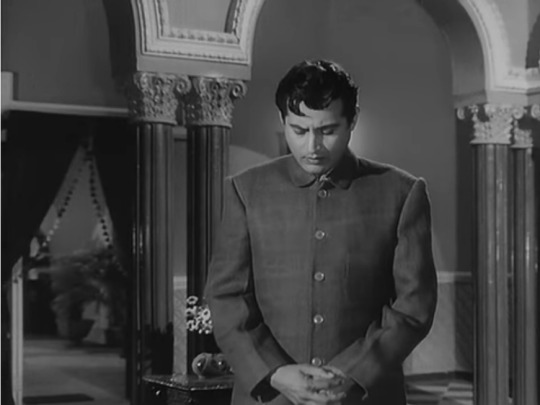
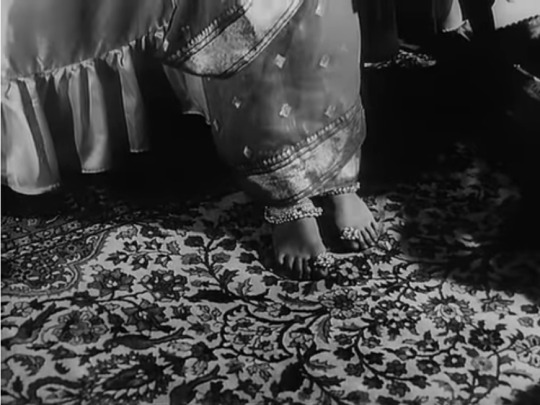
Sahib Bibi Aur Ghulam (1962) | dir. Abrar Alvi | d.o.p. V. K. Murthy
#Sahib Bibi Aur Ghulam#sahib bibi aur ghulam 1962#Abrar Alvi#meena kumari#Guru Dutt#indian cinema#hindi cinema#bollywood#classic cinema#world cinema#classic bollywood#old bollywood#cinematography#cinema#films#movies#1962#1960s#historical film#indian films#Indian movies#Hindi films#hindi movies#bollywood films#bollywood movies
17 notes
·
View notes
Video
youtube
Seems as if we finally can enjoy a decent quality version of “Kaagaz Ke Phool” (1959, dir. Guru Dutt))! (I strongly recommend youtube channel tommydan55 for watching classic Indian cinema anyway.)
“Kaagaz Ke Phool” has Guru Dutt himself, Waheeda Rehman, Johnny Walker, Minoo Mumtaz, Veena, Mahesh Kaul and Kumari “Baby” Naaz in the lead roles.
Screenplay by Abrar Alvi, lyrics by Kaifi Azmi and Shailendra, music by S.D. Burman, main singers are Geeta Dutt and Mohd. Rafi.
The breathtakingly beautiful and poignant cinematography is by V.K. Murthy (who also has a cameo appearance as assistant director of photography). It was India’s first film in CinemaScope. There is also a second version filmed with conventional lense, as only very few cinemas were able to screen a letterbox movie in those days.

#Kaagaz Ke Phool#Guru Dutt#Old Bollywood#1959#1950s#video#Indian Cinema#Bollywood2#Bollywood#Vintage Bollywood#Waheeda Rehman#Johnny Walker#Minoo Mumtaz#Veena#Mahesh Kaul#Baby Naaz#kumari naaz#abrar alvi#Kaifi Azmi#Shailendra#Geeta Dutt#Mohd Rafi#VKMurthy
32 notes
·
View notes
Photo

Sahib Bibi Aur Ghulam (1962)
16 notes
·
View notes
Photo


30 notes
·
View notes
Photo
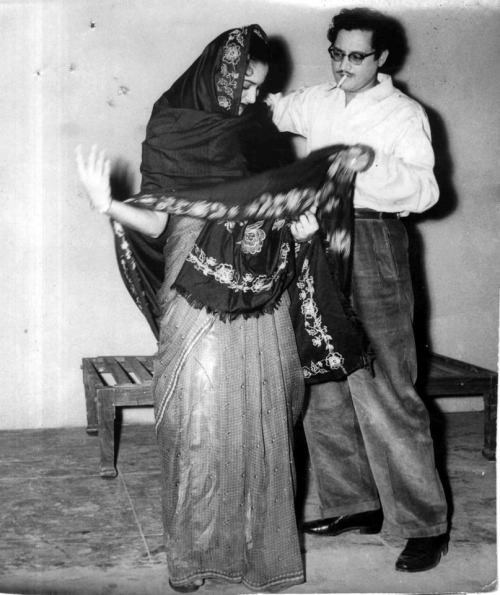
Guru Dutt, Abrar Alvi, and their friends were chatting in their office when a lady, in a burkha, came in to meet them. Abrar was in no mood to meet her but his friends insisted.
When he met the lady, she kept saying that she was a huge fan of Guru Dutt and him, and wanted to work in a film. But when Abrar asked her to show her face, she was reluctant. Soon, Abrar lost his patience and lifted the lady's veil. Everyone started laughing, as the lady turned out to be Waheeda Rahman, carrying out Guru Dutt's prank.
From Sathya Saran's book, "Ten Years With Guru Dutt: Abrar Alvi's Journey"
29 notes
·
View notes
Photo



Sahib Bibi Aur Ghulam (1962) dir. Abrar Alvi
#sahib bibi aur ghulam#bollywood#abrar alvi#guru dutt#Waheeda Rehman#indian cinema#hindi film#classic bollywood#60s movies
27 notes
·
View notes
Text
TABAHIYAN PHIR BHI AYENGI, SHIKAR PHIR SANG LAYENGI. JAB JAB CHAUDHVIN KE CHAND, KAAGAZ KE PHOOL KHILAYENGI. AUR KHUBSURAT INSAAF KI DASTAANEN BAAP-DADAON REHTE PYASI HI REH JAYENGI. - THE SHAMEFUL END TO THE GURU DUTT-GEETA DUTT STORY - THE LIKELY MYSTERIOUS HEART ATTACK TURNED ACCIDENTAL DEATH TURNED SUICIDE! - THE STORY OF THE MOST WRONGED WOMAN OF BOLLYWOOD !
The story of Guru Dutt's death, arguably the greatest actor-director combine India's ever seen, ranked no. 145 on the Indies All-Time Greatest Indian Personalities list btw(!), husband to erstwhile popular playback singer Geeta Dutt, & elder brother of film director Atmaram, has fascinated all Indian film lovers for the past 60 yrs, ever since his shocking so-called suicide was made known to Indian audiences on Oct 10, 1964 morning. No post-mortem report confirming the possibility of such a suicide, or even the presence of all those high number of sleeping pills in deadly combination with very high levels of alcohol, in his body, causing this fatal reaction, has ever come to light.
Instead what's been peddled is the theory that-
Guru Dutt had split from his wife & star singer Geeta Dutt, a few yrs back, primarily on account of his extra-marital affair with Waheeda Rehman, a aspect of his life on which he'd even made a movie called 'Kaagaz Ke Phool' that bombed at the box-office, in 1958, causing a further financial strain on his already tumultuous family life, that made him heavily depressive, causing him to take to a life of heavy drinking, exacerbated by resultant sleep-deprivation causing a further high dependance on sleeping pills, a overall lifestyle that went on to result in such a fatal or suicidal tragedy.
Even Guru Dutt's detailed activities from the day prior to the morning of his death, were made known to the nation via media statements from Guru Dutt's Asst Abrar Alvi (or statements to the nation attributing him as source) (btw, Mr. Alvi has also apparently written a book affirming media statements from then, & also spoken on at different places elsewhere on the same) (as also sourced from sr. journo Shams Tahir Khan’s Yt channel ‘Crime Tak’) who was supposedly present with him since evening 6 pm or so of Oct 9, working on the final scenes or so of a upcoming script of their home production, Guru Dutt Productions film titled 'Baharen Phir Bhi Ayengi' with Guru Dutt in the lead role.
Per the theory narrated by Shams in his YT ‘Crime Tak’ (this morning part obviously sourced from Guru Dutt’s cook with whom he lived in his rented flat at Peddar Road, since Abrar only supposedly arrived that evening), Guru called up his now estranged wife Geeta Dutt (living in the suburbs of Santacruz in Mumbai with their kids) either in the morning or early afternoon, asking her to send their kids over to the Peddar Rd house for a few hrs as he really wanted to spend time with them. She obliged, & the kids did come over in Guru Dutt’s car that he’d sent for them, & spent time with him, & then left to return to Mom's home before evening. However after they left, Guru started feeling desperately emotional to meet them again, & yet again called up Geeta to send the kids back for some more time. By then, Abrar’d arrived home too, & thus supposedly got to know of this interaction. To which Geeta supposedly replied in the negative given how twas turning evening, & said the kids would be better off not being burdened with so much travelling for one day. This supposedly disturbed Guru no end & he started pestering Geeta by calling her up again & again & repeating his demand. All this while he was getting more & more intoxicated & drunk by the hour, in the interim of which Abrar also recalls a friend of Guru working in the Income Tax also arriving & stayed till dinner, that apparently Guru Dutt didn’t eat himself, as was too busy getting drunk instead, after which the friend left, & Abrar & Gutt continued with their script work. Abrar decided to leave for the night at around 1 am, & apparently instructed the cook to not give Guru any more drinks if he so demanded, & left. Guru did ask the cook for drinks, & upon being declined which, took it out himself, & went to his room with his whiskey, & locked the room from within, surely past 2 am or so. Now when his room didn't open for many hours the next morning, the cook called up Geeta who got scared & asked for it to be broken down. The reason for Geeta having gotten scared, as we are then told, is that Geeta was threatened with suicide by Guru, in one of the calls made to her, upon which he broke open the door, to find Guru lying unconscious. A doctor was instantly summoned & Geeta too was telephoned. The doctor came & found him lying dead with strips of empty sleeping pills & a small liquid bottle aside the bottle of alcohol kept on the nearby table, thus driving to the conclusion of his suicide or death by accidental overdose.
(Watch Shams’s narration of the incident of Oct 9-10, 1964, as sourced by him from the archival journals, from 13:15 onwards)
👇
https://www.youtube.com/watch?v=9JrBTjMDX18
In one of the many interviews on that day’s events, that Abrar gave to a documentary production, that’s available on Yt, he further mentions how during that evening convo, Guru started talking to him about ‘crazy people’ & how he’d received a letter from his friend who was now in a mental asylum, a letter that if anyone read, sounded absolutely normal & fine, to which Guru then turned to Abrar, & in Abrar’s own words, told him, “Abrar, sometimes I think I am crazy!”, alluding to Guru’s disturbed state of mind.
👇
(Watch 15:15-16:25)
https://www.youtube.com/watch?v=uCahS0h2FYo&list=PLuoc1SnFXG6mmTyUcH4x6II5bTmbzU-Wi&index=6
Now even popular expert Yt investigative shows like 'Crime Tak' while to be fair only interpreting the available literature from many decades prior, have not gone beyond the usual line in explaining away this lack of post-mortem done thereafter to verify the exact cause of death, by stating how such a post-mortem would anyway not have been able to decipher if these pills & alcohol were consumed in a deliberate suicidal bent of mind or a mere accident from a deadly chemical reaction brought about in sufficiently dosage & intake.
BUT NONE HAVE EVEN VENTURED TO EXPLORE THE QUESTION OF WHETHER HE'D EVEN CONSUMED SUCH SLEEPING PILLS & SUCH ALCOHOL IN THE FIRST PLACE!
TILL TODAY.
And lemme say, almost entirely triggered by today's Yt post from writer-actor-film journalist Shishir Kumar Sharma's Yt channel 'Beete Hue Din', a repost from their own investigation into forgotten artists, from few yrs back, a repost likely inspired by our Kishore Kumar- RD Burman expose from yesterday.:)
This post highlights a forgotten b & w actor called Shyam Kapoor (remember the guy lip-syncing 'Leke pehla pehla pyar bharke aankhon me khumar' from 1956's Guru Dutt produced Dev Anand starrer CID?!!!) stating on record, albeit 4 decades later, with most of his kids well-settled abroad in USA, & he 86 yrs old, in 2014 to Shishir ji who tracked him down to his Versova flat, for the first time, how-
GURU DUTT WAS INFACT SHOOTING FOR HIS HOME PRODUCTION 'BAHAREN PHIR BHI AAYENGI', THE WHOLE DAY OF OCT 9, 1964, AT GURU DUTT STUDIOS, THAT HE WAS PRESENT ON, AS A ASSISTANT DIRECTOR OF THE FILM, TO WITNESS ALL DAY & ENTIRE EVENING, an evening he distinctly remembers also for Mala Sinha, the heroine of the film, incidentally whose death scene (also being the climax scene of the film) was shot for on that very day, having requested Guru Dutt in front of everyone, upon pack-up in the evening, to give her a holiday for the next day, to attend an important premiere in Calcutta, a permission that Guru Dutt did give. He further narrates how Guru Dutt then proceeded to his personal room upstairs in his studios, accompanied by the parallel heroine of the film Tanuja ji, when started feeling his chest in discomfort, to which a concerned Tanuja inquired for his health, to which he replied "I think I'm having a heart problem", & in an instant expression of light amusement turned to Tanuja & exclaimed "Dekho kal Mala bhi nahi aa rahi hai. Artist producer ko heart problem hi to dete hain!", turning everyone's mood jovial & light.
👇
https://www.youtube.com/watch?v=Dwxyc6PQw4U
IF ALL THIS IS TRUE, THEN THIS WAS CERTAINLY NOT A MAN IN A DEPRESSED STATE OF MIND, INFACT QUITE THE OPPOSITE.
IF ALL THIS IS TRUE, THEN GURU DUTT DIED FROM A HEART ATTACK, MOST LIKELY AS A RESULT OF MULTIPLE HEART ATTACKS IN THE EARLY MORNINGS OR SO OF OCT 10, 1964, GIVEN HOW WE WAS LIKELY EXPERIENCING HIS FIRST HEART ATTACK IN THE EVENING OF OCT 9, IN FRONT OF TANUJA & SHYAM! A YOUNG 39 YR OLD MAN, WITH NO PERSONAL OR KNOWN FAMILIAL HISTORY OF EARLY HEART DISEASE WHATSOEVER!

Bringing us to the next set of mysteries-
What’s with all the other, totally different picture, presented by Abrar Alvi & Guru Dutt’s cook on Guru most likely having committed suicide, or having died in severe overdose of depression-induced pills & booze, due to his tattered personal life??
A story which itself has innumerable flaws & holes in it btw, on account of the statement given by Guru Dutt’s son Arun who was 8 yrs old in 1964, several decades later, available on WildFilmsIndia Yt channel, on how Guru Dutt never spent a single minute of Oct 9, 1964 with him or his siblings, as he was scheduled for a weekly meeting with them the next day ie Oct 10, Arun’s last meeting with his dad having taken place on Oct 3 or so, on his last weekly trip! Also mentioning how his father did not have a telephone in his rented flat at Peddar Road, & so had to go downstairs to his neighbor's house to make a call each time instead! .. Given all this as true, SOUNDS IMPOSSIBLE THAT CELEBRITY GURU DUTT WOULD’VE MADE THOSE INNUMERABLE FRANTIC EMOTIONAL CALLS TO HIS WIFE, ON THE SAME EVENING, FROM HIS NEIGHBOR'S HOUSE, RINGING THEIR BELL & DISTURBING THEM EVERYTIME FOR THE SAME, IN ONE OF WHICH CALLS HE’S EVEN SUPPOSEDLY ALLEGED TO HAVE THREATENED TO COMMIT SUICIDE IF HIS DAUGHTER WASN’T SENT TO HIS PEDDAR ROAD HOME IMMEDIATELY, ALL THIS WHILE AT PER ONE WITNESS HE'D ALREADY MET THEM AMPLY JUST 2-3 HRS BACK, & PER OTHER STORY-MEMBER WERE SET TO MEET JUST FEW HOURS LATER ANYWAY ! .. Neither have his neighbors till today ever mentioned anything about such calls on that day anywhere.
(Watch Arun Dutt’s interview to WildFilmsIndia on Yt)
👇
https://www.youtube.com/watch?v=WY8HDWYtbJA
Furthermore, given how they weren’t hearing this themselves, is it even conceivable that Guru Dutt would come back home after these calls from his neighbor's house below, & inform Abrar & the cook about it’s details??! Also given how Guru Dutt was by all accounts said to be a deep introvert, who certainly wouldn’t be expected to share intimate details about his children & his impulses towards them, with his assistants, howsoever friendly?? Also given how Abrar himself affirms in his book as also mentioned elsewhere, how he never saw Guru losing his composure or being gripped by the effects of alcohol, & behaving like a drunkard, ever, despite being a drinker! How did Abrar & the cook then get to know of such intimate emotional & personal telephone convos by Guru Dutt, that they didn’t overhear ??
NOW LET’S ENVISAGE THE OTHER SCENARIO, NAMELY THAT GURU WAS IN GURU DUTT STUDIOS TILL EVENING OF OCT 9, 1964, PER HIS ASST DIRECTOR SHYAM KAPOOR’S CLAIM-
HE WOULD THEN ONLY HAVE MADE IT BACK HOME BY AROUND 8 PM OR SO, THE TIME ALSO MENTIONED BY HIS SON ARUN (BY WHEN THE KIDS WOULD BE REGULARLY ASLEEP, WHEN LIVING TOGETHER TILL 1963), AS WHEN HE’D REGULARLY ARRIVE HOME EACH NIGHT FROM WORK AT! .. IN THAT CASE, HOW WOULD HE EVER HAVE HAD THE TIME TO POSSIBLY ENVISAGE A PLAN OF CALLING HIS KIDS HOME FROM A PLACE NEARLY AN HOUR AWAY BY CAR, (THE NEXT STORY, THAT NONE OVERHEAR AGAIN, MIND YOU, IS HE WANTED JUST HIS 2 YR OLD DAUGHTER SENT), REACH BY 9 PM, SPEND LEISURE TIME & MAKE THEM REACH BACK HOME AT A TIME NOT LESS THAN MIDNIGHT OR SO, THAT ALL THIS EXERCISE WOULD’VE HAD TO HAVE TAKEN, & WITH THEM HAVING TO ATTEND SCHOOL EARLY MORNING THE NEXT DAY (ST. MARY’S SCHOOL HAD A 7 AM START I THINK), WHILST SCHEDULED TO MEET ALL OF THEM JUST FEW HRS LATER ANYWAY. !?????
FURTHERMORE, ANOTHER BIGGEST HOLE IN THE PEDDLED THEORY! NAMELY THAT GURU DUTT WAS MERELY WORKING ON THE SCRIPTING OF ‘BAHAREN PHIR BHI AYENGI’ BY OCT 1964! .. WHEREAS PER ASST SHYAM KAPOOR, GURU DUTT HAD ALREADY COMPLETED SHOOTING A DECENT AMOUNT (~40%) OF ‘BAHAREN PHIR BHI AYENGI’ BY THEN! (A FACT ALSO ACCEPTED BY DEVI DUTT IN VIDEO & PRINTS INTERVIEWS PRESENTED LATER). SO WHAT IS ABRAR TALKING ABOUT!?? AND WHY???
On this count, we get to know, that his last produced film ‘Baharen Phir Bhi Ayengi’, released ~2 yrs later on Sept 6, 1966, with Dharmendra now playing the hero’s role.
Now remember, per AD Shyam Kapoor, this film was 40% shot & ready, beyond all the pre-production work & everything, by Oct 10, 1964, already! Yet that took a full 2 yrs to complete & be released. AND OF COURSE, WITH GEETA DUTT, THAT SONG IN EVERY HOME PRODN TILL THEN, MISSING IN PLAYBACK.
(Below are stills from Guru Dutt Prods' 'Baharen Phir Bhi Ayengi', with Guru Dutt as hero, that was being shot (as evidenced on one clap clip) certainly in Sept 1964 & likely from while earlier, none of which stills being from any song sequence of the film. These were all scripted scenes.)
👇
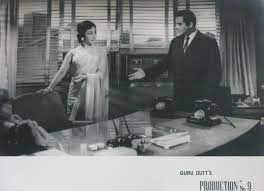


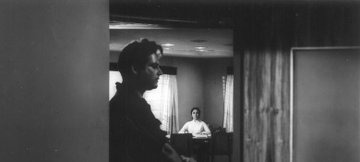

This, per Asst Dir of the film Shyam Kapoor, for distributors (SUPPOSEDLY, AS WE’RE TOLD LATER) placing a strange request in front of Guru Dutt production house to have it re-shot entirely by Abrar Alvi. So while the original director Shaheed Latif’s name is retained as Dir, per an agreement with distributors, Abrar Alvi was assigned the task of re-shooting the film, then lazed around royally with & took ~ 1.5 more years to complete, & per Shyam Kumar, emptied out Guru Dutt Films’s coffers in the process! Why?? Also in this process strengthening Abrar’s own peddled theory of him being in discussions with Guru Dutt on the final scene of ‘Baharen Phir Bhi Ayengi’ on Oct 9, 1964, thus needing a sufficient time gap in eventual release of the film, to prime facie turn his own narrative plausible!
Furthermore, this case enters the SSR domain, when we get to hear of how his cook broke open the door of Guru Dutt’s room, & saw him lying unconscious, & called the doctor & his wife Geeta! .. Broke open the door.. really, sir???! And then, given all the conflicting tales, how does one truthfully account for all those empty sleeping pill strips lying on his table along with some open liquid bottle?? Remember 50s Bollywood was renowned for film noir murder mysteries & crime investigation, yet not even an ordinary post-mortem done here, that too in a case of prime facie suicide, that too of such a huge celebrity????
And then what’s with all that talk of Guru having entertained his kids in his Peddar Road home on afternoon of Oct 9, that obviously would’ve been narrated by the cook, as being the only one around at home at that time, that Guru’s son himself refutes???
Now as if this weren’t enough, we now have another addition to this most twisted of all narrative dump, in the form of Asha Bhosle reportedly having mentioned in a Documentary aired on Doordarshan, how Guru Dutt had called her up at the midnight of his death, inquiring whether his wife Geeta was at her house (just a few blocks away at Peddar Road itself)!
(Watch 16:40-17:20)
https://www.youtube.com/watch?v=HGb18GnqMIQ
So now we are to believe that Guru not only went to his neighbor's house at midnight to make a phone call, to a colleague, inquiring if his wife had traveled half the city, from Santacruz to Peddar Road, to be just a few meters away from her husband’s home, at midnight, when she was anyway scheduled to meet him, just a few hours later with all the kids, as per every week, as also per his brother Devi’s assertion that the 2 had decided to reunite & stay together after a few months, once their redeveloped bungalow-turned-high rise apartment would begin accommodation (Note that per grapevine, Geeta Dutt had some problem with the interior vaastu of her old bungalow, due to which Guru had decided to have it redeveloped into a commercial mutli-residential luxury high-rise in the first place!)
So why did Asha Bhosle say all this, given how we now know it’s almost impossible that Guru Dutt would’ve gone down the stairs & disturbed his neighbor's house post midnight to make a phone call to Asha?
https://udayindia.in/bollywood-suicides/
NOW IT’S ALMOST CERTAIN, THAT THE GURU DUTT SUICIDE THEORY AS PEDDLED BY ABRAR ALVI & THE COOK HAS A PROVERBIAL MILLION FLAWS IN IT, & CAN’T BE ACCEPTED AS TRUTH IN ANY WAY.
Be it for reasons of lack of autopsy or post-mortem, cook’s breaking open of door & said to have found empty sleeping pill strips & open liquid bottle (that neither the police nor the media & newspapers surprisingly followed up on), the cook’s false narrative of the kids having arrived that afternoon, the need for Guru to have gone out of his way to neighbor's house below that evening to make all those supposed emotional self-threatening out-of-control phone calls to his wife, & finally his highly propagandized ‘state of mind’??
Let’s explore this last aspect. It is certain that Guru Dutt was in EXTREMELY GOOD MONETARY CONDITION, for the good foreseeable future, to say the least, given how his last release ‘Chaudhvin Ka Chand’, as we now know, almost entered the Top 100 Biggest Ticket-sellers list, in Hindi Cinematic history!
Furthermore, as his poshest Pali Hill located bungalow had been sold off to prime redevelopers, to be converted into a big posh luxury high-rise apartment (as attested to by his brother Devi Dutt himself in his 2019 interview!), where each of his brothers & their families, incl him & his family, were being given a separate floor each to themselves, or which it is almost certain that he’d have received a very fat sum of money!
Yet, for some strange reason, Guru Dutt’s brother, in a 2019 interview (as well as in a 2015 intv, & perhaps others), while atleast after all these decades, finally coming out to affirm Shyam Kapoor’s claim that Guru Dutt was indeed shooting for ‘Baharen Phir Bhi Ayengi’ till evening for Oct 9th, after which he went shopping with him to Charagh Din, before finally reaching home, leaves it at that, (this too, we suspect, for having known of Shyam Kapoor having come out with his version of facts, in front of the world), mentions how Guru Dutt was in a financially disastrous space, only unknown to the world, for Guru not having declared bankruptcy officially, & with the Income-Tax on his doors ready to raid & take away all his assets at any moment! This to a man, who’s just earned many many tens of crores (then, in non-inflation-adjusted sums) from his most recent universally acclaimed super mega-blockbuster film! Is this even a remotely believable theory for the world to buy into!???
👇
https://www.filmfare.com/features/women-were-ready-to-do-anything-for-guru-dutt-devi-dutt-28634-2.html
Below is Devi Dutt on video saying that Guru Dutt had already picturized the songs of ‘Baharen Phir Bhi Ayengi’ with the cast members!
(Watch 7:00-8:12)
https://www.youtube.com/watch?v=PQIl6Qw5WQI
All this, while Abrar Alvi, is on record on video (posted above), saying that even the script of the film was not finalized yet, & that he was still writing the final scenes of the film with Guru Dutt on the day of Guru Dutt’s death!
Also, all this, while Asst Director Shyam Kapoor, has on record stated that, twas the climax/final scene of ‘Baharen Phir Bhi Ayengi’ that was being shot on Oct 9 with Mala Sinha, 1964, before Guru’s death on Oct 10 night or early morning!
THIS IS A DIRECT MISMATCH BTWN ALL THE 3 (STAR) WITNESSES, & ARUN DUTT & THE COOK, ON KEY EVENTS OF THE DAY!
WHY WOULD GEETA BE SENDING THE KIDS TO GURU'S FLAT ON OCT 9 (PER DEVI DUTT, ABRAR ALVI, & OTHERS) SPECIALLY, WHEN THEY WERE ALL SCHEDULED TO MEET THE VERY NEXT DAY ANYWAY, PER WEEKLY ROUTINE? FURTHERMORE, WHEN THEY WERE ALL SET TO REUNITE & LIVE TOGETHER AGAIN ONCE THEIR NOW REDEVELOPED LUXURY BUILDING WOULD BE READY JUST A FEW MONTHS LATER (ALSO AS LET OUT BY DEVI DUTT)? .. ALL THIS WAS BEING DONE, TO ESTABLISH A NARRATIVE OF GURU DUTT'S DESPERATE EMOTIONAL STATE ON OCT 9 NIGHT, ON WHICH HIS 'THE END' WAS DECIDED!
(Below is their family pic from, we’re safely guessing (given Nina’s age in pic), one of their weekly meetings).
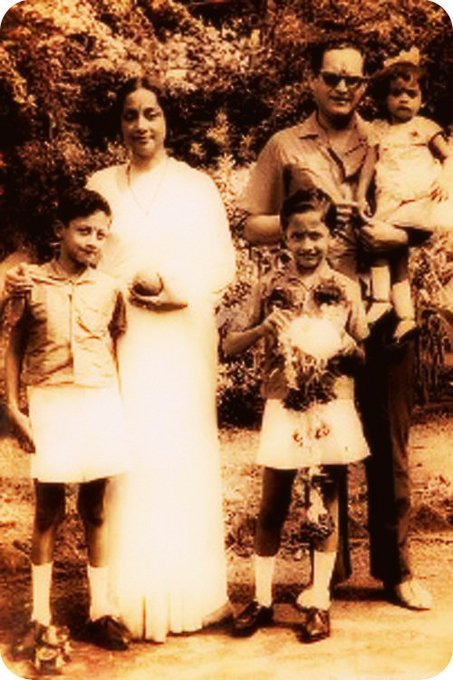

ALSO, HOW COULD GURU DUTT HAVE HAD 2 YEARS HEAVY BACK-TAXES PENDING, EVEN THREATENING FORECLOSURE OF THE ENTIRE GURU DUTT PRODUCTION HOUSE, WHEN HE'D JUST EARNED, IN TODAY'S EQUIVALENT, A SUM OF ~900 CRORE RUPEES FROM HIS NEAR LAST RELEASED FILM (’CHAUDHVIN KA CHAND’) JUST BEFORE IT !
Btw, as an unconnected aside, we also hear from Shyam Kapoor himself, how Guru’s brother Atmaram, who takes over production duties of Guru Dutt Films after Guru’s demise, makes his next film ‘Shikar’ in 1968, (from the profits earned from the super-hit ‘Baharen Phir bhi Ayengi’ in 1966), that’s a full 4 yrs after Guru’s death, which is a big hit (ranked only at 950 or so at Indies All-Time Popularity meter, but supposedly rakes in such huge money), that he buys land in Versova from it’s profits & builds an entire building in Guru Dutt’s name from it, housing the permanent staff of Guru Dutt Films, incl Shyam Kapoor too btw, permanently in few of the flats therein too.
AMAZING HOW A FILM, THAT BARELY MAKES IT TO TOP 1000 BIGGEST BOLLY MONEY-EARNERS, (IE BOTH 'SHIKAR' IN 1968 & 'BAHAREN PHI BHI AYENGI' IN 1966), CAN CAUSE PRODUCER TO RAISE A FULL BUILDING IN PRIME LAND IN THE MOST EXPENSIVE RESIDENTIAL CITY ON EARTH, BUT A FILM TWENTY TIMES MORE PROFITABLE (IE 'CHAUDHVIN KA CHAND' IN 1960, ONE OF THE BIGGEST BLOCKBUSTERS IN INDIAN HISTORY!) CAUSES THE SAME PRODUCTION COMPANY TO REACH THE VERGE OF TOTAL BANKRUPTCY & TAKE-OVER JUST THE NEXT TO NEXT YEAR!
Also Devi Dutt’s full story seeming a further half-truth too, as nowhere mentions about Guru Dutt’s heart pain on that day, which was apparent to all those around him! That too when he’s supposed to then have gone shopping with his brother Devi, from the studios, before reaching home, spending a good 2 hours with him for sure in the process, yet not mentioning a word on his highly discomforting heart condition to his own brother!??
Now onto his emotional state of being. By what we’ve heard from Shyam Kapoor, he seemed most relaxed, & far from disturbed. Further given how he went shopping with his brother on his way home, shows how he was in a very normal worldly space too.
So either Shyam Kapoor, or Devi Dutt, & certainly Abrar Alvi, & Guru Dutt’s cook, are lying through their teeth in all this!
One thing we do notice though- It almost seems as if the entire larger Guru Dutt family, reveled in Guru Dutt dying of suicide, in front of the world, as also seen from his own sister’s near-glorification of her brother’s (so-called) terrible mental condition, at every given turn.
Let’s just call it their amateurish way of honoring artistic brilliance & genius, & leave it at that.
And to put aside, the one lingering postulated theory on Guru’s supposed extra-marital affair with Waheeda Rehman, causing him to separate from his wife. - Anyone observing this relationship over the many decades we’ve seen Waheeda ji talk about it first hand, will know how twas purely & purely a student-teacher bond (and actors are known to have more emotional bonds with their colleagues than in other professions anyway generally), unless we’re forced to believe Waheeda ji to be the greatest actress on earth off-screen too, for half a century and more, & in a very shady context at that.
Also, to the fashionable persisting rumor of Guru Dutt having made ‘Kaagaz Ke Phool’ as an autobiography to mourn his broken marriage on account of Waheeda-
Anyone, & not just Waheeda ji who’s clarified it innumerable times, with a purist bent of cinematic heart & brain, will tell you, how it was a direct Indian adaptation of 1954′s massive Hollywood Judy Garland blockbuster ‘A Star Is Born’, also accommodating scenes, perhaps, from his encounter with Master Nissar during it’s filming, as Indies has blogged on before!
(Below is pic of ‘malkin’ of Guru Dutt Prods, Geeta Dutt, attending her film’s ‘mahurat’ accompanied by her husband Guru Dutt)

Also, whatever all these shady characters around keep telling us about his previous suicide attempts, many of whom have been shown to be blatant & cunning liars, at various points in this blog, I, I, REJECT THE THEORY THAT GURU DUTT EVEN ONCE ATTEMPTED SUICIDE ALL LIFE !
The reason for Geeta & Guru Dutt separating, can be attributed to a combination of all the factors that does lead to such drifts in relationships generally, including Guru Dutt’s mother having a dislike for Geeta Dutt & spending her time trying to break the couple up, as alleged by Guru Dutt’s eldest son Tarun Dutt in an article for “Cine Blitz” magazine in 1980′s (it’s excerpts appended at bottom), & as also alluded to by Guru’s younger brother Devi as to the families playing a part in their separation, ... but nothing unique beyond it, as far as we can see, as also given how Geeta was doing reasonably well for her career even during her marriage, & did give some of the most classic, everlasting & eternal songs for Guru Dutt’s films, during this time, whilst also averaging 125-130 songs per year all thru her husband’s life (ie with no restriction from her husband on singing outside) (info available via simple wiki search)!!!

Now onto larger objectives-
Given that 2 independent sources have confirmed that Guru Dutt was indeed at Guru Dutt Studios till evening of Oct 9, 1964, we can more confidently start believing it, as also given the many loopholes in alternative theory proposed by Abrar Alvi & Guru Dutt’s cook.
Question now arises as to why that (now rubbished) theory was proposed in the first place? What was so unacceptable to ‘them’, at having Guru Dutt die of a heart attack? It wasn’t as if this was an impossible or unimaginable occurrence, even at the age of 39 then? Even Guru’s brother Devi who’s finally come out to accept the theory that Guru was at studios that day, stops short of completely endorsing Shyam Kapoor’s theory of Guru staying there till evening or experiencing heart trouble since Oct 9 morning.
Why did they instead want him dying of a sleeping pill & booze overdose since the early evening of Oct 9??? All this while, we know from Kishore Kumar's death analysis, how these heart attacks (as also experienced by Guru Dut that day) can also be induced in Bollywood! Was this all per a script given by some master planner?
This clearly was being done to bring firstly his mental health into the picture, secondly his failed marriage into the picture, & in such away, surely then drag his wife into the picture too!
This plan, by whomsoever that we don’t know about, had something to do with publicly straining the bond btwn Geeta & Guru to such an extent, that Geeta would be ashamed to even come near any of Guru’s properties after his death?? Geeta is even badmouthed in one of her extended family’s interview above saying Geeta became a charasi, & a drug addict, who took drugs in the morning & afternoon, & heavy booze at night, in few music sittings that a family member himself had to physically keep her from falling over in front of the mike. All this btw while Geeta Dutt sang some of her best songs for 1971’s Anubhav, just a year before her death! Argh, film families!
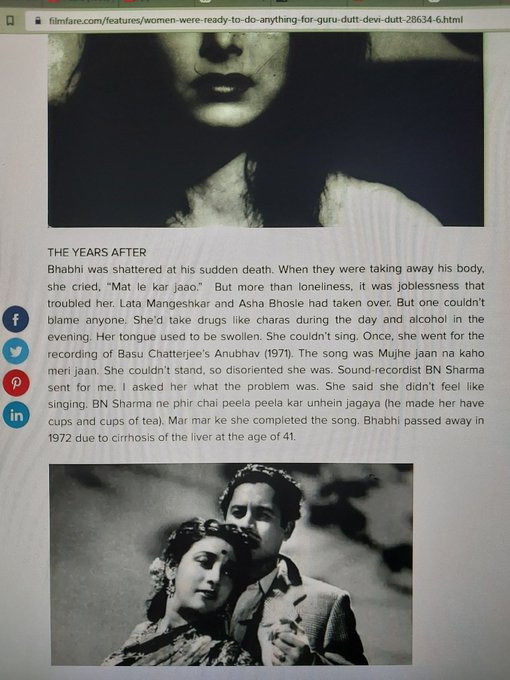
But wait, why so publicly badmouth & humiliate the widow of your elder brother, & continue with the character assassination after she's passed away too, the wife of an elder brother who was like a father figure to y'all siblings all life, as mentioned in different interviews in print by the family, after the brother's passed away? ..
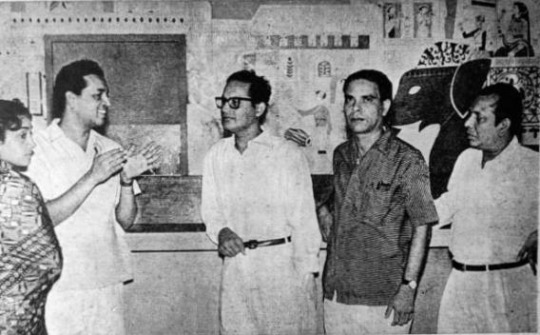
Furthermore, how was in such dire financial straits, that this legendary singer, a senior star to even Lata Mangeshkar, was forced to cut discs for local Durga pujas, & even act in 2 Bengali films (one released in Dec 1965 & another in 1967), for a living, (btw, what of that posh luxury high-rise at 48 Pali Hill?) all this while Guru Dutt Productions was very much afloat (& one would’ve imagined thriving big time, after Chaudhvin Ka Chand!?) & she surely a part of it's profits!? The Production House was infact so publicly thriving by 1968 that a whole high rise building named 'Guru Dutt Apartments' was soon constructed, by the new controller of Guru Dutt Productions, Guru's brother Atmaram, at prime land in Versova, with some of the most expensive properties prices on earth, even giving away ownership of flats in it to the permanent staff of Guru Dutt Productions, incl Shyam Kapoor (above)! .. And also, if she was in such a deep state of nervous breakdown borne of mourning & regret from her husband’s death (remember that last Guru Dutt suicide threat we have been peddled with all life?), that she supposedly couldn't even recognize her kids for 6 months, followed by her continued disorientation thereafter, so much that couldn’t even stand on her own later (as told by various publications online, incl the above Devi intvw), how did she then appear as a heroine in a Bengali film called 'Malajanjha' released on Dec 10, 1965, for which she would've surely started in early 1965, just 2-3 months after her husband's death, & another film 'Bodhu Baran' released on Jan 1, 1967 ? ......... All this was obviously being done to JUSTIFY HER UNNATURAL TOTAL DISAPPEARANCE FROM THE PLAYBACK SINGING SCENE AFTER GURU'S DEATH (she barely sang 4 songs a year on avg, in the playback scene, in all the remaining 8 yrs of her life).
...
And to further debunk claims of her bad singing health & overall health 1965 onwards, below is a 2015 video interview of Geeta Dutt's real kid brother Milan Roy Chowdhury stating how Geeta was attending blockbuster sell-out concerts all across the West Indies, in 1966 , singing 25-30 songs non-stop at each choc-a-bloc pit-stop of the tour, with admirable energy & zest as complimented on by all & sundry present there, per Milan, to regalia & jubilation from the Hindi Music crazy crowds there, as witnessed by Milan himself, who Geeta had called over to be with her all through the West Indies tour, from Michigan, USA, where he was studying then, (infact he narrates the incident of how Geeta organized to have his student brother's ticket pre-booked, pre-paid, & ready for his mere pick-up at his Detroit airport desk itself, right from West Indies) & there are even photographs of Milan with Geeta from the hotel room from that big 1966 West Indies tour on Facebook (infact evidenced on the thumbnail of the below video itself).
Geeta Dutt was clearly in absolutely perfect physical, mental & emotional (& also good monetary for sure too) (& by herself) health, ALL THROUGHOUT THE LATTER HALF OF THE 60s, totally contrary to the claims made by Devi et al!
(Watch 14:00-17:00 of Milan Roy Chowdhury’s interview)
👇
https://www.youtube.com/watch?v=B2lI32H4Y4c

(Also watch from 21'-24' on how Geeta always was a very warm & kind-hearted, jovial, & fun-loving person, fluent in many languages, & full of energy & joi de vivre.)
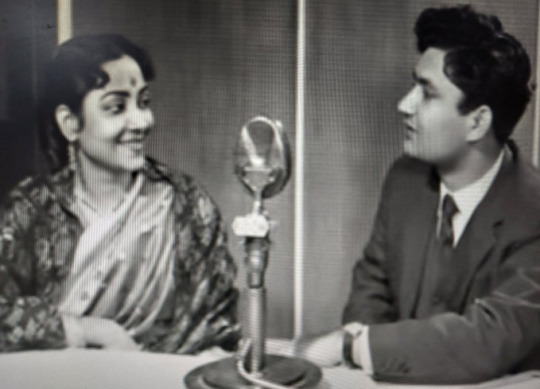
Below are stills from Geeta Dutt's 2nd Bengali film 'Badhu Baran' released in 1967, paired opposite Pradeep Kumar!
This film incidentally also marked the debut of Raakhee in Indian Cinema.
👇






Below is Geeta Dutt hosting a radio prog for soldiers IN 1969.
👇
a. https://www.youtube.com/watch?v=ZLyccOZ5vM4
b. https://www.youtube.com/watch?v=ELoHx_UTKNg&list=PLB9B4264417853926&index=1
Another pic of a plumper Geeta Dutt singing with Mohd Rafi that's come to light, CLEARLY seems FROM 1967, given how we've seen her physical progression, mood of song, & & it being a Rafi duet (from Geeta's discography.
👇

Below are photo clips from a Geeta Dutt interview IN LATE 1960′S, informing the world of her new innings AS A BOLLYWOOD ACTRESS. that she'd already begun, having been signed to act in a Hindi color film for legendary Dir H.S.Rawail, & also being in discussions for another film with Sunil Dutt.
👇



And below are her 2 last recorded songs in 1972 for the unreleased film ‘Midnight’, one of them a duet with Talat Mehmood, & the other a beautiful solo, all this while she could (supposedly once again) barely stand for herself & had to be “maar maar ke” made to sing her (super classic btw) songs in 1971′s ‘Anubhav’!
👇
1. https://www.youtube.com/watch?v=nGZAtE2Rww0
2. https://www.youtube.com/watch?v=_9dRYi3nsNg
.
.
YOU THINK A DRUNKARD & A CHARASI CAN SPEND HER TIME SO PRODUCTIVELY & DO EVEN A FRACTION OF ALL THIS ??!!
This whole after-story seemingly then, most likely, if not certainly, was a plan, by whomsoever, the real perpetrators that we don’t know of, some masterminds, TO FINISH OFF & MAKE PITIABLE, THE LEGACY OF, both ‘Romeo & Juliet’ in every way possible, & in one fell swoop.
But who could’ve had a problem with both Geeta Dutt & Guru Dutt at the same time?? One thing Geeta was benefiting from Guru, was in bagging the choicest, plummest & most eternal songs coming from his stables. Did someone resent that aspect?? But who ??
And so be fair then, if we collectively end this blog, by expressing our serious doubts over the naturalness of the 1972 death of one of India’s oldest star singers, Geeta Dutt too, at age 41, at this juncture, supposedly as told by media from liver cirrhosis caused from heavy decades-long alcohol addiction! - the wrong couple in the wrong half of the wrongest century in modern Indian history!
(& 1972 also when, OP Nayyar, Geeta's mentor composer, suddenly announces his retirement from Bollywood!)
Did You Know:
Guru Dutt's eldest son Tarun Dutt also(supposedly)"committed suicide" barely into his 30s,in the 1980′s, a successful director himself of the 1985 Rekha-starrer 'Bindiya Chamkegi'! !
Tarun had just before written an article in "Cine Blitz" titled 'Was Guru Dutt Murdered?'-alleging people high up in the Bombay Film Industry as being involved in the plot!

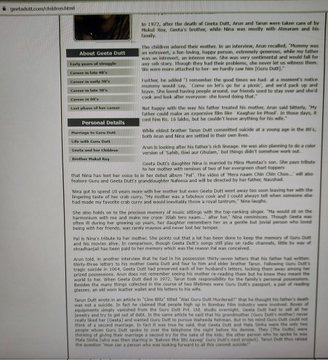

BOLLYWOOD SUCCESS, W/O ANY ‘HIDDEN INVESTMENTS’ TO ACQUIRE SUCH SUCCESSES, ONCE AGAIN, SHOWN TO BE UNSUSTAINABLE.
HENCE PROVEN..
Guru Dutt was right after all. "Aisi duniya mil bhi jaye toh kya hai”
🎵 https://www.youtube.com/watch?v=BC2BcEyrOjU 🎵
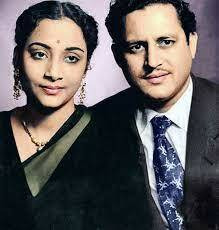

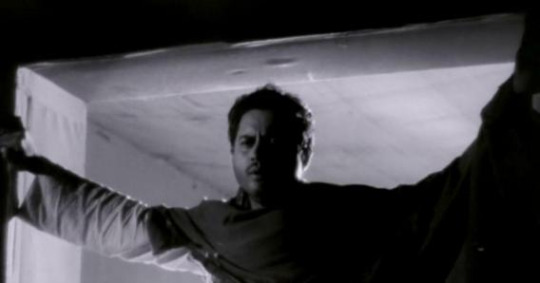
1 note
·
View note
